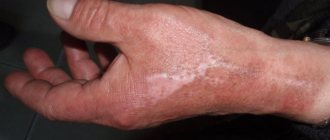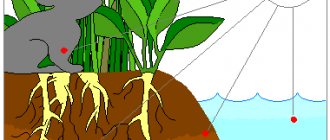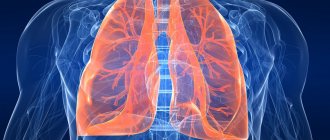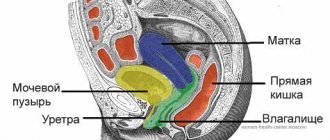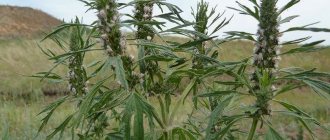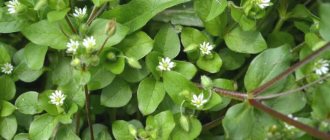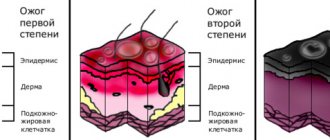| Iodine | |
| Atomic number | 53 |
| Appearance of a simple substance | |
| Properties of the atom | |
| Atomic mass (molar mass) | 126.90447 a. e.m. (/mol) |
| Atomic radius | n/a |
| Ionization energy (first electron) | 1,008.3 (10.45) kJ/mol () |
| Electronic configuration | [Kr] 4d10 5s2 5p5 |
| Chemical properties | |
| Covalent radius | 133 |
| Ion radius | (+7e) 50 (-1e) 220 |
| Electronegativity (Pauling) | 2,66 |
| Electrode potential | 0 |
| Oxidation states | 7, 5, 3, 1, -1 |
| Thermodynamic properties of a simple substance | |
| Density | 4,93 /³ |
| Molar heat capacity | 54.44[1]/(mol) |
| Thermal conductivity | (0,45) /(·) |
| Melting temperature | 386,7 |
| Heat of Melting | 15.52 (II) kJ/mol |
| Boiling temperature | 457,5 |
| Heat of vaporization | 41.95 (II) kJ/mol |
| Molar volume | 25.7 ³/mol |
| Crystal lattice of a simple substance | |
| Lattice structure | orthorhombic |
| Lattice parameters | 7,720 |
| c/a ratio | n/a |
| Debye temperature | n/a |
| I | 53 |
| 126,90447 | |
| 5s25p5 | |
| Iodine | |
Iodine
,
iodine
(from ancient Greek ιώδης, iodes - “violet”) is an element of the main subgroup of the seventh group, the fifth period of D. I. Mendeleev’s periodic system of chemical elements, with atomic number 53. Denoted by the symbol I (Latin Iodum). A chemically active non-metal, belongs to the group of halogens. The simple substance iodine (CAS number: 7553-56-2) under normal conditions is black-gray crystals with a violet metallic luster; it easily forms violet vapors with a pungent odor. The substance molecule is diatomic (formula I2).
In medicine and biology, this substance is usually called iodine.
(for example, “iodine solution”), in the periodic table and chemical literature the name
iodine
.
Being in nature
It is found in large quantities in the form of iodides in sea water. It is also known in nature in free form, as a mineral, but such finds are rare - in the thermal springs of Vesuvius and on the island. Vulcano (Italy). Reserves of natural iodides are estimated at 15 million tons, 99% of reserves are located in Chile and Japan. Currently, intensive iodine mining is carried out in these countries, for example, the Chilean Atacama Minerals produces over 720 tons of iodine per year.
The raw material for the industrial production of iodine in Russia is oil drilling water, while in foreign countries that do not have oil fields, seaweed is used, as well as mother liquors of Chilean (sodium) nitrate, which makes the production of iodine from such raw materials much more expensive.
Physical properties
The vapors have a characteristic purple color, just like solutions in non-polar organic solvents such as benzene - in contrast to the brown solution in a polar alcohol. Iodine at room temperature appears as dark purple crystals with a faint luster. When heated at atmospheric pressure, it sublimates (sublimates), turning into violet vapor; When cooled, iodine vapor crystallizes, bypassing the liquid state. This is used in practice to purify iodine from non-volatile impurities.
Chemical properties
Iodine forms a number of acids: hydroiodic (HI), hypoiodic (HIO), iodous (HIO2), iodic (HIO3), iodic (HIO4).
Chemically, iodine is quite active, although to a lesser extent than chlorine and bromine.
- When slightly heated, iodine reacts energetically with metals, forming iodides:
Hg + I2 = HgI2
- Iodine reacts with hydrogen only when heated and not completely, forming hydrogen iodide:
I2 + H2 = 2
- Elemental iodine is an oxidizing agent, less powerful than chlorine and bromine. Hydrogen sulfide H2S, Na2S2O3 and other reducing agents reduce it to the I- ion:
I2 + H2S = + 2HI
- When dissolved in water, iodine partially reacts with it:
I2 + H2O = + HIO
History of discovery
Iodine was first obtained in 1811 by the Frenchman Courtois. He was a chemist, and at the same time the owner of a saltpeter factory. He obtained soda for making saltpeter from the ash of seaweed. When Courtois added concentrated sulfuric acid to the ash brine, a reaction began, releasing purple fumes that smelled like chlorine.
It was iodine vapor. True, rumor attributes the discovery not to Courtois himself, but to his cat. Allegedly, the animal accidentally knocked over a vessel with acid onto the ash brine.
In 1813-14, French and English chemists, Gay-Lussac and Davy, identified a new element and named it iodine from the Greek ioides, violet. Literally immediately after its discovery, in the 20s of the 19th century, the beneficial properties of iodine as a medicine in the treatment of thyroid diseases were studied.
It is noteworthy that until the middle of the last century the substance was called iodine, and in the periodic table it was designated by the letter J, Jodum. Then they decided to designate the element as iodine, and the letter J was replaced by I.
However, both in Russian and in some European languages, along with the generally accepted term, they continue to use the old one. The name “iodine” is used colloquially, as well as to refer to medications and biological processes.
Application
Medicine
A 5% alcohol solution of iodine is used to disinfect the skin around an injury (torn, cut or other wound), but not for oral administration if there is iodine deficiency in the body. Products of iodine addition to starch, other BMCs (“ Blue iodine
"- Iodinol, Yox, Betadine) are milder antiseptics.
It is widely used in alternative (unofficial) medicine, but its use without a doctor’s prescription is generally poorly justified, and is often accompanied by various advertising statements.
see also
- Zelenka
- Fukortsin
Battery production
Iodine is used as the positive electrode (oxidizing agent) in lithium-iodine batteries for electric vehicles.
Laser fusion
Some organoiodine compounds are used to produce high-power gas lasers using excited iodine atoms (laser fusion research and industry).
Radioelectronics industry
In recent years, the demand for iodine from manufacturers of liquid crystal displays has sharply increased.
Dynamics of iodine consumption
World consumption of iodine in 2005 amounted to 25.5 thousand tons.
basic information
Iodine is an essential element necessary for life. It is best known for its role in the production of thyroid hormones in humans, as well as in all vertebrates. Iodine deficiency can lead to serious health problems, including goiter (enlarged thyroid gland), mental retardation and cretinism.
As a pure element, it is a shiny purple-black non-metal that is solid under standard conditions. It easily changes from a solid to a gaseous state, bypassing the liquid form, and emits a purple vapor. Although it is technically a non-metal, it does have some metallic qualities. The main characteristics of the element are:
- Name: Iodine.
- Symbol: I.
- Atomic number: 53.
- Atomic mass: 126.90447 a. eat.
- Melting point: 113.5 °C.
- Boiling point: 184.0 °C.
- Electronic formula of iodine (Electronic configuration): 1s22s22p63s23p63d104s24p64d105s25p5.
- Atomic structure: number of protons - 53, electrons - 53, neutrons - 74.
- Valence variable: -1, +1, (+3), (+4), +5, +7.
- Classification: halogen.
- Crystal structure: rhombic.
- Density at 20°C: 4.93 g/cm3.
- Color: black-gray.
Biological role
Iodine is a trace element and is present in all living organisms. Its content in plants depends on the presence of its compounds in soil and water. Some seaweeds (seaweed, or kelp, fucus and others) accumulate up to 1% iodine. Iodine is included in the skeletal protein of sponges and the skeletal proteins of marine polychaete worms.
In animals and humans, iodine is part of the so-called thyroid hormones produced by the thyroid gland - thyroxine and triiodothyronine, which have a multifaceted effect on the growth, development and metabolism of the body.
The human body (body weight 70 kg) contains 12-20 mg of iodine, the daily requirement for iodine is about 0.2 mg (200 mcg). The absence or deficiency of iodine in the diet (which is typical in some areas) leads to diseases (endemic goiter, cretinism, hypothyroidism). In this regard, potassium iodide, sodium iodide or potassium iodate (iodized salt) are added to table salt sold in areas with a natural geochemical deficiency of iodine.
Isotopes of the element
Only one natural isotope of the element is known - iodine-127. Isotopes are two or more forms of an element. They differ from each other by their mass number. The number written to the right of the element's name is the mass number. It represents the number of protons plus neutrons in the nucleus of an element's atom. The number of protons defines an element, but the number of neutrons in an atom of any one element can vary. Each variation is an isotope.
Approximately 30 radioactive isotopes of iodine have been produced artificially. These are isotopes that break apart and release some form of radiation. They are formed when very small particles burn atoms. These particles stick to atoms and make them radioactive.
Application of isotopes
A number of iodine isotopes have commercial uses. For medical purposes, they are introduced into the patient's body through the mouth and then pass through the body in the bloodstream. When they travel, they emit radiation. This radiation is detected using X-ray film. A medical professional can tell how well the body is functioning by observing the radiation pattern. Iodine isotopes are also used for the following purposes:
- Iodine-123 - in studies of the brain, kidneys and thyroid gland.
- Iodine-125 - to study the pancreas, blood flow, liver, mineral absorption in the bones and protein loss in the body.
- And iodine-131 is used in studies of the liver, kidneys, blood flow, lungs, brain, and pancreas.
The most common isotope is iodine-131. When ingested, it tends to go directly to the thyroid gland and is then used to produce thyroid hormones.
Toxicity
Iodine is a toxic substance. Lethal dose 2-3 g. Causes damage to the kidneys and cardiovascular system. When inhaling iodine vapor, a headache, cough, runny nose appears, and possibly pulmonary edema. Contact with the mucous membrane of the eyes causes lacrimation, eye pain and redness. If ingested, general weakness, headache, vomiting, diarrhea, brown coating on the tongue, heart pain and increased heart rate appear. After a day, the kidneys become inflamed and blood appears in the urine. If left untreated, the kidneys may fail within 2-3 days and myocarditis may occur. Without treatment, death occurs.
- Thyroiditis
Content
- 1 Name and designation
- 2 History
- 3 Being in nature
- 4 Physical properties 4.1 Isotopes
- 6.1 In medicine
- 7.1 Iodine and the thyroid gland
Physical properties
Liquid iodine at the bottom of a beaker
Natural iodine consists of only one isotope - iodine-127 (see Isotopes of iodine). The configuration of the outer electron layer is 5s2p5. In compounds it exhibits oxidation states −1, 0, +1, +3, +5 and +7 (valences I, III, V and VII).
The radius of the neutral iodine atom is 0.136 nm, the ionic radii of I−, I5+ and I7+ are, respectively, 0.206; 0.058-0.109; 0.056-0.067 nm. The energies of sequential ionization of a neutral iodine atom are equal, respectively: 10.45; 19.10; 33 eV. Electron affinity −3.08 eV. According to the Pauling scale, the electronegativity of iodine is 2.66, iodine is a non-metal.
Under normal conditions, iodine is a solid substance, black-gray or dark purple crystals with a weak metallic luster and a specific odor.
The vapors have a characteristic purple color, just like solutions in non-polar organic solvents, for example, benzene - in contrast to the brown solution in polar ethyl alcohol. Slightly soluble in water (0.28 g/l), better soluble in aqueous solutions of alkali metal iodides to form triiodides (for example, potassium triiodide KI3).
When heated at atmospheric pressure, iodine sublimates (sublimates), turning into violet vapor; When cooled at atmospheric pressure, iodine vapor crystallizes, bypassing the liquid state. This is used in practice to purify iodine from non-volatile impurities.
Liquid iodine can be obtained by heating it under pressure.
Isotopes
There are 37 known isotopes of iodine with mass numbers from 108 to 144. Of these, only 127I is stable, the half-life of the remaining iodine isotopes ranges from 103 μs to 1.57⋅107 years;
individual isotopes are used for therapeutic and diagnostic purposes. The radioactive nuclide 131I decays with the emission of β-particles (the most probable maximum energies are 0.248, 0.334 and 0.606 MeV), as well as with the emission of γ-quanta with energies from 0.08 to 0.723 MeV.
Signs of iodine deficiency
The following symptoms of iodine deficiency indicate that a person needs additional iodine:
• Increased fatigue, fatigue • Headaches • Accumulation of excess weight • Constipation • Dry skin, dull hair, brittle nails, etc.
The listed symptoms occur in many people. In case of severe iodine deficiency, suppression of the thyroid gland and the development of hypothyroidism can occur. In this case, the above-mentioned symptoms are accompanied by a decrease in body temperature, abnormal blood pressure, impotence in men, cycle disorders in women, infertility, severe drowsiness, etc.

